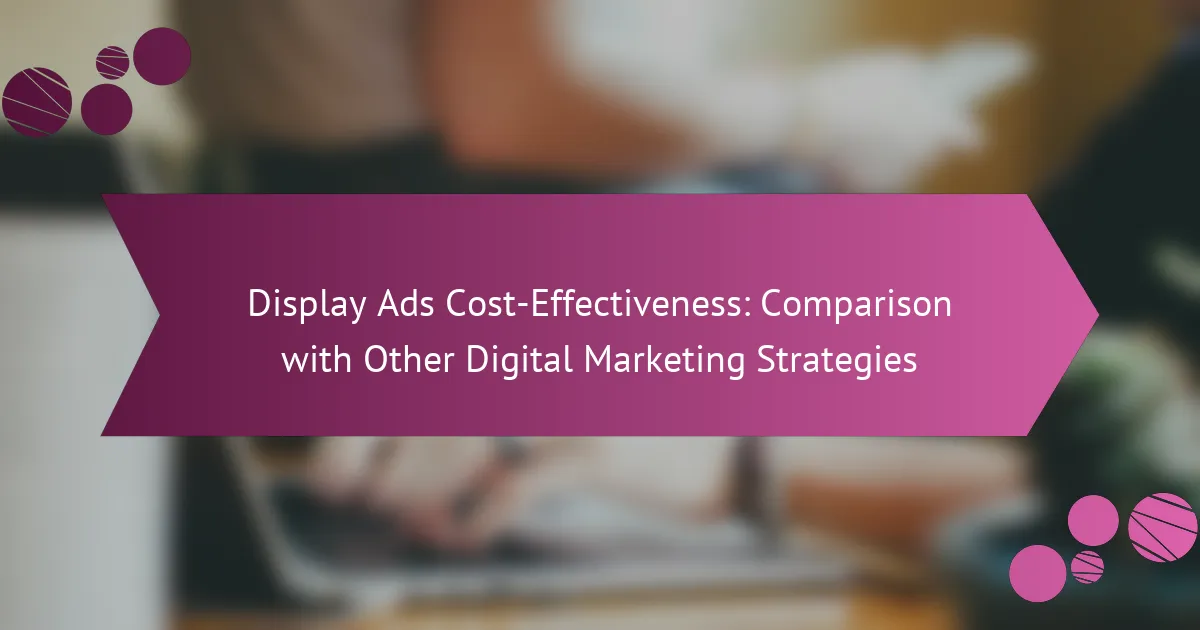Display ads present a compelling cost-effective option for marketers, especially when compared to social media marketing and search ads. By focusing on cost per impression rather than engagement, display advertising can enhance brand visibility and reach a wider audience. Understanding the factors that influence display ad costs, such as placement and targeting, is essential for optimizing campaign effectiveness and maximizing return on investment.

How do display ads compare in cost-effectiveness to social media marketing?
Display ads can be more cost-effective than social media marketing, particularly when considering their reach and impression costs. While social media platforms often charge for engagement, display ads typically focus on cost per impression, making them a viable option for brand visibility.
Lower cost per impression
Display ads generally offer a lower cost per impression compared to social media marketing. Advertisers can expect to pay anywhere from a few dollars to low tens of dollars per thousand impressions (CPM), depending on the platform and targeting options. This cost efficiency allows brands to maximize their visibility without overspending.
In contrast, social media marketing often involves higher costs for engagement-based metrics, such as clicks or likes. This can lead to increased spending without guaranteed visibility, making display ads a more budget-friendly choice for many businesses.
Higher ROI potential
Display ads can provide a higher return on investment (ROI) when executed effectively. By leveraging targeted placements and retargeting strategies, businesses can reach potential customers at various stages of the buying journey, increasing the likelihood of conversions. Many advertisers report that well-optimized display campaigns can yield ROI in the range of 200-400% or more.
In comparison, social media marketing may not always convert as effectively, especially if the audience is not well-defined. Display ads can tap into broader audiences while still maintaining a focus on conversion, enhancing overall ROI potential.
Targeting capabilities
Display ads offer robust targeting capabilities that can enhance their cost-effectiveness. Advertisers can utilize demographic, geographic, and behavioral targeting to reach specific audiences, ensuring that their ads are seen by the most relevant users. This precision helps in optimizing ad spend and improving conversion rates.
Social media platforms also provide targeting options, but they can be limited by user engagement levels and algorithm changes. Display ads, on the other hand, allow for more granular control over where and to whom ads are shown, making them a strategic choice for businesses looking to maximize their marketing budgets.

What factors influence the cost of display advertising?
The cost of display advertising is influenced by several key factors, including ad placement, audience targeting options, and the duration and budget of the campaign. Understanding these elements can help marketers optimize their spending and improve the effectiveness of their ads.
Ad placement and visibility
Ad placement significantly impacts the cost of display advertising. Premium placements, such as above-the-fold positions on high-traffic websites, typically command higher prices due to increased visibility and engagement potential. In contrast, ads placed in less prominent positions may be more affordable but could result in lower click-through rates.
Additionally, the visibility of an ad can be enhanced by choosing well-known platforms or websites that align with the target audience. Consider testing various placements to find the right balance between cost and effectiveness.
Audience targeting options
Audience targeting is another crucial factor affecting display advertising costs. More precise targeting options, such as demographic, geographic, or behavioral targeting, often come at a premium. However, these options can lead to higher conversion rates by ensuring that ads reach the most relevant users.
Marketers should evaluate their audience data and consider using a combination of targeting methods to maximize return on investment. For example, retargeting ads can be particularly effective, as they focus on users who have previously interacted with the brand.
Campaign duration and budget
The duration of a display advertising campaign and its overall budget also play significant roles in determining costs. Longer campaigns may benefit from reduced costs per impression due to bulk purchasing options, while shorter campaigns might incur higher rates for immediate visibility.
Establishing a clear budget and timeline is essential for effective campaign planning. Marketers should regularly assess performance metrics to adjust spending and duration as needed, ensuring that they remain within budget while optimizing ad effectiveness.

What are the benefits of display advertising over search ads?
Display advertising offers unique advantages over search ads, primarily in brand visibility and engagement. While search ads target users actively looking for specific products or services, display ads can reach a broader audience and create brand awareness even among those not currently searching.
Broader brand visibility
Display ads appear on various websites and platforms, allowing brands to reach a wider audience beyond just search engine results. This increased exposure can help establish brand recognition and familiarity, which is crucial for long-term customer relationships.
For instance, a company selling outdoor gear can display ads on travel blogs, lifestyle sites, and social media, capturing the attention of potential customers who may not be actively searching for their products but are interested in outdoor activities.
Visual engagement opportunities
Display advertising leverages visuals, such as images, videos, and animations, to engage users more effectively than text-based search ads. This visual appeal can capture attention quickly and convey messages more dynamically.
For example, a vibrant banner ad showcasing a new product can entice users to click through, whereas a text ad may not stand out as much. Brands can use compelling visuals to tell their story and highlight key features, making their offerings more memorable.
Retargeting capabilities
Retargeting is a powerful feature of display advertising that allows brands to reconnect with users who have previously interacted with their site. By displaying ads to these users across various platforms, brands can remind them of their products and encourage them to return and complete a purchase.
This strategy can significantly improve conversion rates, as users who have already shown interest are more likely to engage again. For instance, if a user visits an online store but leaves without buying, retargeting ads can remind them of the items they viewed, increasing the chances of a sale.

How can businesses optimize their display ad spend?
Businesses can optimize their display ad spend by strategically managing their campaigns through testing, audience targeting, and performance analysis. Effective optimization involves understanding which elements drive engagement and adjusting budgets accordingly to maximize return on investment.
Utilizing A/B testing
A/B testing allows businesses to compare two versions of an ad to determine which performs better. By changing one variable at a time, such as the headline or image, companies can identify the most effective elements for their audience. Aim to run tests over a sufficient period to gather meaningful data, ideally at least a week.
For example, if you have two different calls to action, test them with similar audience segments to see which generates more clicks. This method can lead to incremental improvements that significantly enhance overall campaign performance.
Implementing audience segmentation
Audience segmentation involves dividing your target market into distinct groups based on demographics, interests, or behaviors. This enables businesses to tailor their display ads to resonate more effectively with each segment, improving engagement rates. Consider using data analytics tools to identify key characteristics of your audience.
For instance, a retail brand might segment its audience by age and shopping habits, creating specific ads for millennials versus older shoppers. This targeted approach can lead to higher conversion rates and a more efficient ad spend.
Monitoring performance metrics
Regularly monitoring performance metrics is crucial for optimizing display ad spend. Key metrics to track include click-through rates (CTR), conversion rates, and cost per acquisition (CPA). By analyzing these metrics, businesses can identify which ads are underperforming and adjust their strategies accordingly.
Utilize tools like Google Analytics or ad platform dashboards to gain insights into your campaigns. Set benchmarks for your metrics based on industry standards to evaluate success and make informed decisions about budget allocation and ad adjustments.

What are common misconceptions about display advertising costs?
Many people believe that display advertising is prohibitively expensive and ineffective. However, the reality is that costs can vary widely based on targeting, placement, and campaign goals, making display ads a flexible option for various budgets.
Display ads are always expensive
While some display advertising options can be costly, many platforms offer flexible pricing models that accommodate different budgets. For instance, cost-per-click (CPC) and cost-per-thousand-impressions (CPM) models allow advertisers to control spending based on their specific needs.
Small to medium-sized businesses can often find effective display ad solutions starting from a few hundred dollars per month. By carefully selecting targeting options and placements, advertisers can maximize their return on investment without overspending.
Display ads have low conversion rates
It’s a common belief that display ads yield low conversion rates compared to other digital marketing strategies. However, conversion rates can vary significantly based on factors such as ad design, targeting accuracy, and the relevance of the landing page.
In many cases, display ads can effectively build brand awareness and drive traffic, which may not immediately translate to conversions but can lead to higher engagement over time. To improve conversion rates, focus on compelling visuals, clear calls-to-action, and retargeting strategies to reach users who have previously interacted with your brand.









